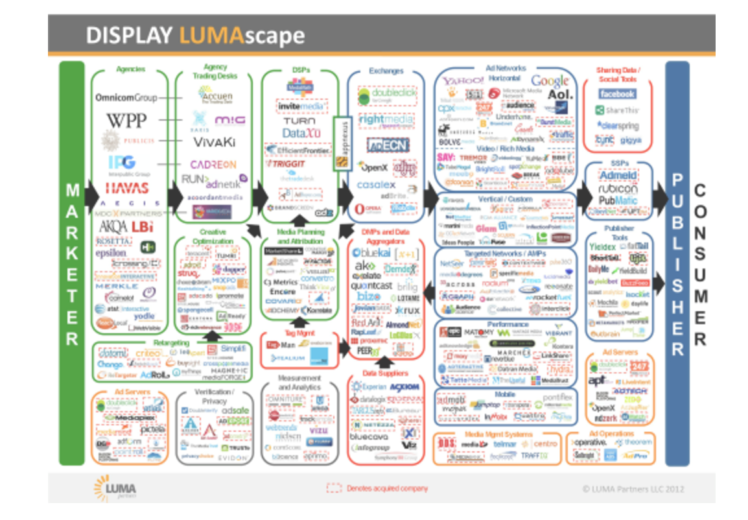Programmatic can be a tricky channel to navigate. One of the biggest pieces of a successful programmatic strategy is the selection of the best buying solution for your needs. However, the landscape and choices available are so vast and wide that it can be confusing, stress inducing, and bring you down so many time-sucking rabbit holes. I mean, look at this graphic.

Above is an illustration of all the different options and layers that currently exist in the programmatic landscape. IN-SANE. It is so hard to know where to start.
DSPs have developed the reputation of having insanely high budget minimums to access the platforms, which can be at times very difficult to convince your clients to test. It can be very off putting. There are, however, options. Many of the major DSPs have re-sellers of their platforms, which provide SMBs access to these enterprise products with much lower commitments of. These platforms offer multiple services in helping advertisers ramp up in the programmatic sector.
There is also the option of low barrier DSPs such as Sitescout and Adroll. These platforms offer much of the benefits of programmatic with less of the bells and whistles in comparison to the major platforms and are suited towards the low end of the budget spectrum.
Then finally, there is also the managed programmatic services such as Quantcast, that offer programmatic expertise and proprietary data in the execution of campaigns.
Deciding on a platform can be a stressful decision. Can I afford it? Does it offer what I need? How much help can I get? Will it work?
I have worked with many different programmatic platforms over the course of my career, and when faced with evaluating a new one, I have the same 6 section checklist that I use to evaluate partners.
1) Pricing
This is the biggest factor for many clients when choosing a programmatic platform. Is there a high minimum? Can it be negotiated as your ramp up? It is also important to see if there are any onboarding, required training fees. The true cost of media is also an important topic to discuss. Most DSPs charge a mark up on media spend, it can range from 15% to 25% depending on their business model. Others, charge a flat CPM for the cost of media, where they then make a margin based. Make sure you know exactly what you are paying and what for.
Be prepared to push hard on these questions to avoid any shocks when you receive your invoice.
2) Transparency
This is one of the biggest issues that hangs over the entire programmatic industry. Inventory, placements, and true cost have all been hot button topics lately. When talking with a potential vendor, be sure to push them about the transparency of their placements, inventory sources, and a breakdown of costs (actual media vs. markup).
Programmatic is a major commitment for many advertisers. You want to be 100% confident that you can trust your vendor. That their goals are aligned with yours and that you provide the highest quality of advertising to your clients is crucial.
3) Targeting Options
The advanced targeting options are what make programmatic the phenomenon it is. When choosing your vendor, you want to make sure that you can do everything that you plan to do. It is important to ask your vendor about the different features that they can offer. Can you utilize Programmatic Direct Deals or Private Market Places, what data partners do they work with for audience targeting and/or brand safety? Another important feature is the ability to use 1st party CRM and Email list data.
Programmatic is essentially an expensive GDN if you cannot utilize all the applicable targeting capabilities to their fullest extent. Make sure that you are not leaving anything on the table.
4) Support
This is an important aspect, in my opinion, especially for those of you entering the world of programmatic for the first time. Will you have access to a dedicated account manager that you can reach out to with questions, troubleshooting, or account issues? Or will you just have access to a generic support@wedonthavetime email address that takes days to receive a response from? If this is the case, be sure to ask about support issue turnaround times. Does the platform have a strong “Help” section or training sections?
You are paying a lot of money to these platforms, regardless how you access them. Make sure that you are being helped in the right way and not throwing money down the drain.
5) Technology
Each programmatic platform has it’s own proprietary technology and/or data integrations that provide their unique selling point in the market, but not every vendor makes sense for every advertiser. For example, a vendor who offers hyper local radius targeting designed for franchises or chains, may not make sense for the B2B client with a single location.
The key thing to look towards is, does the technology or data being described to me make sense to my overall campaign goals. The landscape above shows that there are multiple technology offerings, make sure that it is the right type for your strategy.
6) Tracking
In a performance marketing world, we are judged by our metrics, and the impact that our advertising has on those metrics. Most DSPs and or vendors offer basics such as conversion tracking, basic ad tracking etc. However, in the case of others, including some of the larger platforms, B2C metrics such as revenue and detailed attribution required layered on extra tools and platforms to report against media spend.
Conclusion
Deciding on a viable programmatic vendor can be a taxing process. There are multiple things to consider and it can be very confusing. However, if you follow the above approach to evaluating vendors, you will be able to find one that you can truly trust to help you execute your programmatic strategy.



